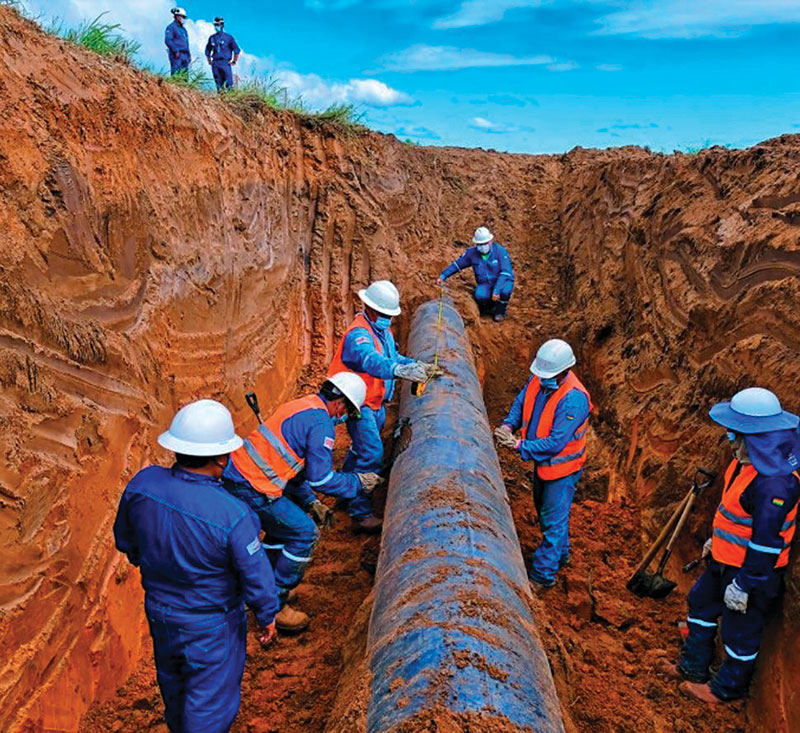October 2021, Vol. 248, No. 10
Features
Bolivia’s YPFB Transporte to Boost Gas Pipelines Capacity
By Mauro Nogarin, Contributing Editor
YPFB Transporte S.A.’s objectives for 2021 are to increase natural gas production and meet the growing demands of the domestic market, such as respecting the contracts with Brazil and Argentina.

In general terms, the new investment plan of the state company also contemplates restructuring YPFB to modernize the management as well as technically and economically optimize the YPFB plants to maximize exports.
The president of YPFB, Wilson Zelaya, recently confirmed that $400 million of the $800 million investment plan for 2021 will be allocated to exploration projects that will be executed directly by the state company.
An additional $140 million will be allocated for the most important projects, which will allow operational continuity and improve capacity in pipelines, multipipelines and gas pipelines.
There will also be an investment of $150 million in exploitation and development, an amount that will allow production natural gas volumes to be recovered to an average of 50 MMcf/d (1.4 MMcm/d), after registering the lowest production in the last five years, with 43.17 MMcf/d (1.223 MMcm/d).
YPFB Transporte will increase the transportation capacity in its hydrocarbon transportation system through pipelines.
The company has been executing a portfolio of projects not only for the expansion of the systems, but also to ensure the continuity and operational security of the transport service, as well as to improve the efficiency of the operations.
According to the new expansion plan of YPFB Transporte, which is currently being developed, four projects will enter into operation between December 2021 and July 2022:
The Tarabuco-Sucre Gas Pipeline (GTS) expansion aims to increase transportation capacity through the construction of a 10-inch-diameter, 14-mile (22-km) gas pipeline on the Tarabuco-to-Yamparaez section (Chuquisaca region), to increase the natural gas transportation capacity from 29.9 to 45.2 MMcf/d (0.85 to 1.28 MMcm/d), thus responding to the growing demand for gas in the cities of Sucre and Potosí. The construction phase of the project is currently underway.
The Sucre-Potosí Gas Pipeline (GSP) Expansion Phase II consists of the construction of a 10-inch, 8.6-mile (14-km) loop in the Río Pilcomayo Mariaca section (Potosí region).
It will expand the transportation capacity from 10.3 to 12.7 MMcf/d (0.29 to 0.36 MMcm/d). The project is being executed in response to the need to meet the incremental demand of the cities Sucre and Potosí, mainly generated by the new ECEBOL Cement Plant in Potosí. Necessary engineering is being developed to begin the construction phase soon.
Expansión Norte is a project to expand the transportation capacity from 133 to 163 MMcf/d (3.8 to 4.6 MMcm/d) of the Carrasco-Yapacaní Gas Pipeline (GCY), through the implementation of a 16-inch pipeline loop, running 18.6 miles (30 km) to ensure the supply for the Carrasco node.
The Carrasco node includes important consumption points such as thermoelectric plants. This expansion will also guarantee the supply of the Cochabamba market, which, together with the Carrasco-Cochabamba Gas Pipeline (GCC) and the Altiplano Gas Pipeline (GAA), supply the Oruro and La Paz markets. The project began operations recently and is developing closing activities.
The Camiri-Sucre Polyduct (PCS) expansion project aims to increase its current capacity of 3,334 bpd through the adaptation of a line that will be transferred from the 6-inch GTS gas pipeline system to operate as a multipipeline. In synergy with other service continuity projects, this will increase transportation capacity, depending on their execution (replacement of pumping units and integrity work on the Chorety-Tapirani sections).
With the execution of this project, it is intended to gradually meet the growing demand for finished products (gasoline, liquid petroleum gas [LPG], kerosene, diesel oil) required by the markets of Potosí and mainly Sucre, as well as the areas of influence depending on the supply strategy that is defining YPFB regarding the origin of the finished products.





Comments